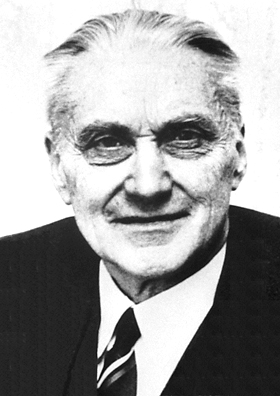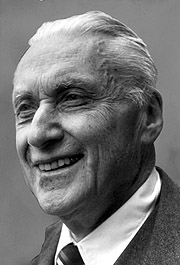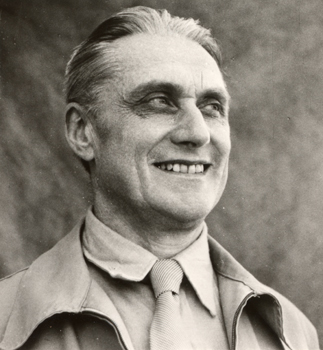<Back to Index>
- Economist Ragnar Anton Kittil Frisch, 1895
- Composer Louis Charles Bonaventure Alfred Bruneau, 1857
- General of the U.S. Army Matthew Bunker Ridgway, 1895
PAGE SPONSOR



Ragnar Anton Kittil Frisch (March 3, 1895 – January 31, 1973) was a Norwegian economist and the co-winner with Jan Tinbergen of the first Nobel Memorial Prize in Economic Sciences in 1969. He is known for having founded the discipline of econometrics, and in 1933 to have created the widely used term pair macroeconomics / microeconomics.
Ragnar Frisch was born on March 3, 1895 in Oslo as the son of gold- and silversmith Anton Frisch and Ragna Fredrikke b. Kittilsen. Being expected to continue his family business, Frisch became an apprentice in the David Andersen workshop in Oslo. However, at his mother's advice, while doing his apprenticeship Frisch also started studying at the University of Oslo. His chosen topic was economics, as it seemed to be "the shortest and easiest study" available at the university, and passed his degree during 1919. During 1920 he also passed his handicraftsman tests and became a partner in his father's workshop.
During 1921 Frisch received a fellowship from the university which enabled him to spend three years studying economics and mathematics in France and England. After his return to Norway, during 1923, although the family's business was having difficulties, he continued his scientific activity, believing that research, not jewellery, was his real career. He published a few papers about probability theory, started teaching at the University of Oslo during 1925 and, during 1926, he gained his Ph. D with a thesis in mathematical statistics.
Also during 1926, Frisch published an article outlining his view that economics should follow the same path towards theoretical and empirical quantization that other sciences, especially physics, had followed. During the same year, he published his seminal article "Sur un problème d'économie pure" starting the implementation of his own quantization programme. The article offered theoretical axiomatizations which result in a precise specification of both ordinal and cardinal utility, followed by an empirical estimation of the cardinal specification. Frisch also started lecturing a course on production theory, introducing a mathematization of the subject.
Frisch received a fellowship from the Rockefeller Foundation to visit the United States during 1927. There, he attempted to associate with other economists interested with the new mathematical and statistical approaches to economics, including Irving Fisher, Wesley Clair Mitchell, Allyn Young and Henry Schultz. He wrote a paper analyzing the role of investment in explaining economic fluctuations. Wesley Mitchell, who had just written a book on business cycles, popularized Frisch's paper which was introducing new advanced methods.
Although his fellowship was extended to travel to Italy and France, the next year Frisch had to return to Norway because of his father's death. He spent one year to modernize and recapitalize his family's workshop by selling family assets and to find a jeweller to manage the business for him. Then he resumed academic work, during 1928 being appointed Associate Professor of statistics and economics at the Oslo University. During 1927 and 1928 Frisch published a series of articles on the statistics of time series. During 1929 he published his first important essay on econometric methodology, "Correlation and scatter in statistical variables", followed in the same year by "Statics and dynamics in economic theory", which introduced dynamics in economic analysis.
Frisch became a full Professor at the university during 1931. He also initiated at the university the Rockefeller funded Institute of Economics during 1932 and became its Director of Research.
Frisch married Marie Smedal during 1920 and they had a daughter, Ragna. His granddaughter, Nadia Hasnoui (Ragna's child), became a Norwegian television performer. After his first wife died during 1952, he remarried during 1953 with childhood friend Astrid Johannessen.
Ragnar Frisch received the Antonio Feltrinelli prize from the Accademia Nazionale dei Lincei during 1961 and the Nobel Memorial Prize in Economic Sciences during 1969 (awarded jointly with Jan Tinbergen) for "having developed and applied dynamic models for the analysis of economic processes".
Frisch was one of the founders of economics as a modern science. He made a number of significant advances in the field of economics and coined a number of new words including econometrics and macroeconomics. His 1926 paper on consumer theory helped set up Neo - Walrasian research. He formalized production theory (1965). In econometrics he worked on time series (1927) and linear regression analysis (1934). With Frederick Waugh, he introduced the celebrated Frisch – Waugh theorem (Econometrica 1933) (sometimes referred to as the Frisch – Waugh – Lovell theorem). His 1933 work on impulse propagation business cycles became one of the principles of modern New Classical business cycle theory. He also helped introduce econometric modeling to government economic planning and accounting. He was one of the initiators of the Econometric Society and editor of Econometrica for over twenty years. The Frisch Medal, so named in his honor, is given every two years for the best paper published in the aforementioned Econometrica in the previous five years.
Frisch's most important hobby was bee keeping, for which Frisch performed genetic studies.